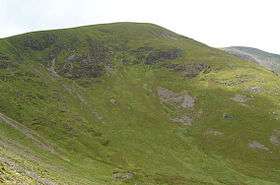
Studding sail
A studding sail, studsail or stunsail (traditionally pronounced stuns'l) is a sail used to increase the sail area of a square rigged vessel or 1950s racing skiffs in light winds.
It is an extra sail hoisted alongside a square-rigged sail on an extension of its yardarm. It is named by appending the word studding to the name of the working sail alongside which it is set.
Studding sails have also been used to increase the sail area of a fore-and-aft spanker, again by extending the upper spar. Such a sail extending the leech of a fore-and-aft sail is known as a ringtail. Ringtail sails were used by Flying 18 foot skiffs in Sydney Harbour in the 1950s to enlarge the downwind sailing capacity in light airs. Sails that extend below the boom to deck level or lower are known as watersails.
References

Sail
A sail is a catchment device designed to receive and redirect a force upon a generous surface area. Traditionally, the surface was engineered of woven fabric and supported by a mast, whose purpose is to propel a sailing vessel. Sails may be configured in many ways to include traditionally understood maritime purposes, as well as land vehicles and solar collection purposes. The rich encyclopedic history of maritime sails suggests alternative uses of the technology well documented.
History of sails
Archaeological studies of the Cucuteni-Trypillian culture ceramics show use of sailing boats from the sixth millennium onwards. Excavations of the Ubaid period (c. 6000 -4300 BC) in Mesopotamia provides direct evidence of sailing boats. Sails from ancient Egypt are depicted around 3200 BCE, where reed boats sailed upstream against the River Nile's current. Ancient Sumerians used square rigged sailing boats at about the same time, and it is believed they established sea trading routes as far away as the Indus valley. The proto-Austronesian words for sail, lay(r), and other rigging parts date to about 3000 BCE when this group began their Pacific expansion.Greeks and Phoenicians began trading by ship by around 1,200 BCE.

Sail (Lake District)
Sail is a hill in the English Lake District, lying between Derwentwater and Crummock Water.
Topography
The North Western Fells occupy the area between the rivers Derwent and Cocker, a broadly oval swathe of hilly country, elongated on a north-south axis. Two roads cross from east to west, dividing the fells into three convenient groups. The central sector, rising between Whinlatter Pass and Newlands Pass, includes Sail. The highest ground in the North Western Fells is an east-west ridge in this central sector, beginning with Grasmoor above Crummock Water and then gradually descending eastwards over Crag Hill, Sail, Scar Crags and Causey Pike.
Sail is in every sense a satellite of Crag Fell, although having sufficient prominence to be listed as a Hewitt. From the summit of Crag Hill the eastward ridge narrows between opposing walls of crag. This rocky crest is The Scar, the depression being at around 2,425 ft. The roughness decreases as the rounded top of Sail is reached, and the ridge then turns east north east. A further depression at 2,015 ft leads to the summit of Scar Crags. This col is unnamed on maps of the Ordnance Survey, but Alfred Wainwright termed it Sail Pass in his influential Pictorial Guide to the Lakeland Fells

Sail (anatomy)
A sail is a large, flattish protrusion from the back of an animal colinear with the spine. Many extinct species of amphibians and reptiles have very extended neural spines growing from their back vertebrae. These are thought to have supported a sail. Paleontologists have proposed many ways in which the sail could have functioned in life.
Function
Many suggestions have been made for the function of the sail. The consensus amongst modern scholars is that, at least for the pelycosaurs, the sail was used for thermoregulation.
Thermoregulation
The structure may have been used for thermoregulation. The base of the spines have a channel which it is proposed contained a blood vessel supplying abundant blood to the sail. The animal could have used the sail's large surface area to absorb heat from the sun in the morning. As ectotherms they required heat from an external source before their muscles would start to function properly. A predator would thus have an advantage over its slower moving prey. The sail could be used in reverse if the animal was overheating. By standing in the shade, the sail would radiate heat outwards.
Podcasts:

